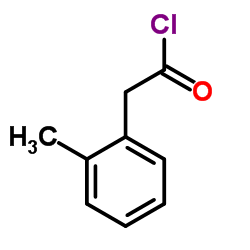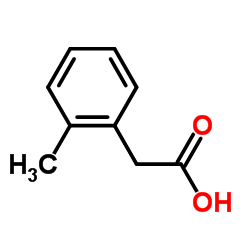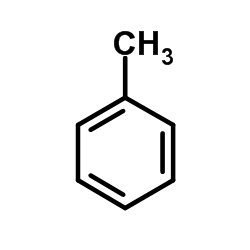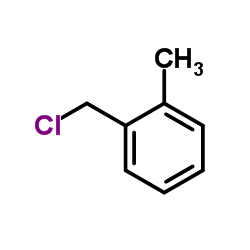2-methylbenzyl isocyanate
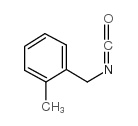
2-methylbenzyl isocyanate structure
|
Common Name | 2-methylbenzyl isocyanate | ||
|---|---|---|---|---|
| CAS Number | 56651-58-2 | Molecular Weight | 147.17400 | |
| Density | 1.059 g/mL at 25 °C(lit.) | Boiling Point | 226 °C(lit.) | |
| Molecular Formula | C9H9NO | Melting Point | N/A | |
| MSDS | Chinese USA | Flash Point | 210 °F | |
| Symbol |


GHS05, GHS07 |
Signal Word | Danger | |
| Name | 1-(isocyanatomethyl)-2-methylbenzene |
|---|---|
| Synonym | More Synonyms |
| Density | 1.059 g/mL at 25 °C(lit.) |
|---|---|
| Boiling Point | 226 °C(lit.) |
| Molecular Formula | C9H9NO |
| Molecular Weight | 147.17400 |
| Flash Point | 210 °F |
| Exact Mass | 147.06800 |
| PSA | 29.43000 |
| LogP | 1.83080 |
| Index of Refraction | n20/D 1.528(lit.) |
| InChIKey | VNHPWTGETWKSLP-UHFFFAOYSA-N |
| SMILES | Cc1ccccc1CN=C=O |
| Storage condition | 2-8°C |
Synonym:None Section 2 - COMPOSITION, INFORMATION ON INGREDIENTS
Risk Phrases: 20/21/22 36/37/38 Section 3 - HAZARDS IDENTIFICATION EMERGENCY OVERVIEW
Harmful by inhalation, in contact with skin and if swallowed. Irritating to eyes, respiratory system and skin.Moisture sensitive.Lachrymator (substance which increases the flow of tears). Potential Health Effects Eye: Causes eye irritation. Lachrymator (substance which increases the flow of tears). Skin: Causes skin irritation. Ingestion: May cause irritation of the digestive tract. Inhalation: Causes respiratory tract irritation. Chronic: No information found. Section 4 - FIRST AID MEASURES Eyes: Flush eyes with plenty of water for at least 15 minutes, occasionally lifting the upper and lower eyelids. Get medical aid immediately. Skin: Get medical aid. Flush skin with plenty of water for at least 15 minutes while removing contaminated clothing and shoes. Wash clothing before reuse. Ingestion: Never give anything by mouth to an unconscious person. Get medical aid. Wash mouth out with water. Inhalation: Remove from exposure and move to fresh air immediately. If not breathing, give artificial respiration. If breathing is difficult, give oxygen. Get medical aid. Notes to Physician: Antidote: None reported. Section 5 - FIRE FIGHTING MEASURES General Information: As in any fire, wear a self-contained breathing apparatus in pressure-demand, MSHA/NIOSH (approved or equivalent), and full protective gear. During a fire, irritating and highly toxic gases may be generated by thermal decomposition or combustion. Extinguishing Media: Use carbon dioxide or dry chemical. Section 6 - ACCIDENTAL RELEASE MEASURES General Information: Use proper personal protective equipment as indicated in Section 8. Spills/Leaks: Absorb spill with inert material (e.g. vermiculite, sand or earth), then place in suitable container. Clean up spills immediately, observing precautions in the Protective Equipment section. Provide ventilation. Section 7 - HANDLING and STORAGE Handling: Wash thoroughly after handling. Use with adequate ventilation. Avoid breathing dust, vapor, mist, or gas. Avoid contact with eyes, skin, and clothing. Keep container tightly closed. Avoid ingestion and inhalation. Storage: Store in a tightly closed container. Store in a cool, dry, well-ventilated area away from incompatible substances. Section 8 - EXPOSURE CONTROLS, PERSONAL PROTECTION Engineering Controls: Use adequate ventilation to keep airborne concentrations low. Exposure Limits CAS# 56651-58-2: Personal Protective Equipment Eyes: Wear appropriate protective eyeglasses or chemical safety goggles as described by OSHA's eye and face protection regulations in 29 CFR 1910.133 or European Standard EN166. Skin: Wear appropriate protective gloves to prevent skin exposure. Clothing: Wear appropriate protective clothing to prevent skin exposure. Respirators: A respiratory protection program that meets OSHA's 29 CFR 1910.134 and ANSI Z88.2 requirements or European Standard EN 149 must be followed whenever workplace conditions warrant respirator use. Section 9 - PHYSICAL AND CHEMICAL PROPERTIES Physical State: Liquid Color: Not available. Odor: Not available. pH: Not available. Vapor Pressure: Not available. Viscosity: Not available. Boiling Point: 65 deg C @ .65mm Hg Freezing/Melting Point: Not available. Autoignition Temperature: Not available. Flash Point: 210 deg F ( 98.89 deg C) Explosion Limits, lower: N/A Explosion Limits, upper: N/A Decomposition Temperature: Solubility in water: Specific Gravity/Density: Molecular Formula: CH3C6H4CH2NCO Molecular Weight: 147.18 Section 10 - STABILITY AND REACTIVITY Chemical Stability: Stable under normal temperatures and pressures. Conditions to Avoid: Incompatible materials, exposure to moist air or water. Incompatibilities with Other Materials: Oxidizing agents. Hazardous Decomposition Products: Carbon monoxide, oxides of nitrogen, irritating and toxic fumes and gases, carbon dioxide. Hazardous Polymerization: Has not been reported Section 11 - TOXICOLOGICAL INFORMATION RTECS#: CAS# 56651-58-2 unlisted. LD50/LC50: Not available. Not available. Carcinogenicity: 2-Methylbenzyl isocyanate - Not listed by ACGIH, IARC, or NTP. Section 12 - ECOLOGICAL INFORMATION Other No information available. Section 13 - DISPOSAL CONSIDERATIONS Dispose of in a manner consistent with federal, state, and local regulations. Section 14 - TRANSPORT INFORMATION IATA Shipping Name: ISOCYANATES, TOXIC, N.O.S.* Hazard Class: 6.1 UN Number: 2206 Packing Group: III IMO Shipping Name: ISOCYANATES, TOXIC, N.O.S. Hazard Class: 6.1 UN Number: 2206 Packing Group: III RID/ADR Shipping Name: ISOCYANATES, TOXIC, N.O.S. Hazard Class: 6.1 UN Number: 2206 Packing group: III Section 15 - REGULATORY INFORMATION European/International Regulations European Labeling in Accordance with EC Directives Hazard Symbols: XN Risk Phrases: R 20/21/22 Harmful by inhalation, in contact with skin and if swallowed. R 36/37/38 Irritating to eyes, respiratory system and skin. Safety Phrases: S 26 In case of contact with eyes, rinse immediately with plenty of water and seek medical advice. S 28A After contact with skin, wash immediately with plenty of water. S 36/37/39 Wear suitable protective clothing, gloves and eye/face protection. S 37 Wear suitable gloves. S 45 In case of accident or if you feel unwell, seek medical advice immediately (show the label where possible). WGK (Water Danger/Protection) CAS# 56651-58-2: No information available. Canada None of the chemicals in this product are listed on the DSL/NDSL list. CAS# 56651-58-2 is not listed on Canada's Ingredient Disclosure List. US FEDERAL TSCA CAS# 56651-58-2 is not listed on the TSCA inventory. It is for research and development use only. SECTION 16 - ADDITIONAL INFORMATION N/A |
| Symbol |


GHS05, GHS07 |
|---|---|
| Signal Word | Danger |
| Hazard Statements | H302-H315-H318-H335 |
| Precautionary Statements | P261-P280-P305 + P351 + P338 |
| Personal Protective Equipment | Eyeshields;Faceshields;full-face respirator (US);Gloves;multi-purpose combination respirator cartridge (US);type ABEK (EN14387) respirator filter |
| Hazard Codes | Xn |
| Risk Phrases | R22 |
| Safety Phrases | S26-S39 |
| RIDADR | UN 3334 |
| WGK Germany | 3 |
| HS Code | 2929109000 |
|
~62% 
2-methylbenzyl ... CAS#:56651-58-2 |
| Literature: Kozhushko, B. N.; Lomakina, A. V.; Paliichuk, Yu. A.; Shokol, V. A. Journal of Organic Chemistry USSR (English Translation), 1984 , vol. 20, p. 654 - 660 Zhurnal Organicheskoi Khimii, 1984 , vol. 20, # 4 p. 721 - 727 |
|
~% 
2-methylbenzyl ... CAS#:56651-58-2 |
| Literature: Journal of Medicinal Chemistry, , vol. 35, # 21 p. 3745 - 3754 |
|
~22% 
2-methylbenzyl ... CAS#:56651-58-2
Detail
|
| Literature: Kozhushko, B. N.; Lomakina, A. V.; Paliichuk, Yu. A.; Shokol, V. A. Journal of Organic Chemistry USSR (English Translation), 1984 , vol. 20, p. 654 - 660 Zhurnal Organicheskoi Khimii, 1984 , vol. 20, # 4 p. 721 - 727 |
| HS Code | 2929109000 |
|---|---|
| Summary | 2929109000. other isocyanates. VAT:17.0%. Tax rebate rate:13.0%. . MFN tariff:6.5%. General tariff:30.0% |
|
Yaws CL
The Yaws Handbook of Vapor Pressure: Antoine coefficients , (2015), 77
|
| R-(+)-methylbenzyl isocyanate |
| (2-methylphenyl)methanisocyanate |
| 2-tolylmethyl isocyanate |
| methylbenzyl isocyanate |
| 2-Methylbenzyl isocyanate |
| (S)-methylbenzyl isocyanate |
| MFCD00673058 |
| 1-isocyanatomethyl-2-methyl-benzene |
